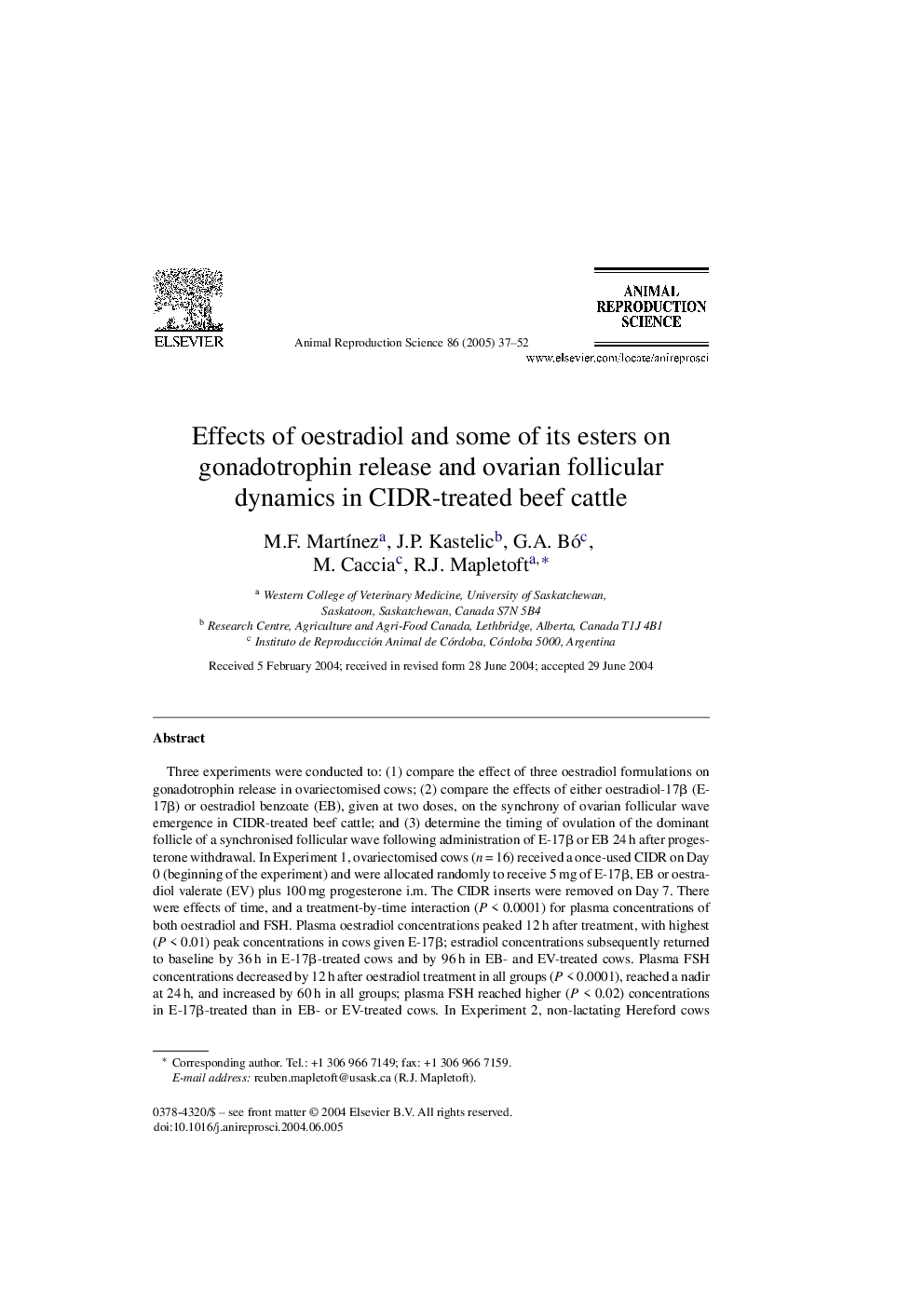| کد مقاله | کد نشریه | سال انتشار | مقاله انگلیسی | نسخه تمام متن |
|---|---|---|---|---|
| 9900348 | 1544842 | 2005 | 16 صفحه PDF | دانلود رایگان |
عنوان انگلیسی مقاله ISI
Effects of oestradiol and some of its esters on gonadotrophin release and ovarian follicular dynamics in CIDR-treated beef cattle
دانلود مقاله + سفارش ترجمه
دانلود مقاله ISI انگلیسی
رایگان برای ایرانیان
کلمات کلیدی
موضوعات مرتبط
علوم زیستی و بیوفناوری
علوم کشاورزی و بیولوژیک
علوم دامی و جانورشناسی
پیش نمایش صفحه اول مقاله

چکیده انگلیسی
Three experiments were conducted to: (1) compare the effect of three oestradiol formulations on gonadotrophin release in ovariectomised cows; (2) compare the effects of either oestradiol-17β (E-17β) or oestradiol benzoate (EB), given at two doses, on the synchrony of ovarian follicular wave emergence in CIDR-treated beef cattle; and (3) determine the timing of ovulation of the dominant follicle of a synchronised follicular wave following administration of E-17β or EB 24 h after progesterone withdrawal. In Experiment 1, ovariectomised cows (n = 16) received a once-used CIDR on Day 0 (beginning of the experiment) and were allocated randomly to receive 5 mg of E-17β, EB or oestradiol valerate (EV) plus 100 mg progesterone i.m. The CIDR inserts were removed on Day 7. There were effects of time, and a treatment-by-time interaction (P < 0.0001) for plasma concentrations of both oestradiol and FSH. Plasma oestradiol concentrations peaked 12 h after treatment, with highest (P < 0.01) peak concentrations in cows given E-17β; estradiol concentrations subsequently returned to baseline by 36 h in E-17β-treated cows and by 96 h in EB- and EV-treated cows. Plasma FSH concentrations decreased by 12 h after oestradiol treatment in all groups (P < 0.0001), reached a nadir at 24 h, and increased by 60 h in all groups; plasma FSH reached higher (P < 0.02) concentrations in E-17β-treated than in EB- or EV-treated cows. In Experiment 2, non-lactating Hereford cows (n = 29) received a new CIDR on Day 0 (beginning of the experiment), and were assigned randomly to receive 1 or 5 mg of E-17β or EB i.m. on Day 1. On Day 8, CIDR were removed and PGF was given. Transrectal ultrasonography was done once daily from 2 days before CIDR insertion to 2 days after CIDR removal, and then twice-daily to ovulation. Although there was no difference among groups in the interval from oestradiol treatment to follicular wave emergence (4.2 ± 0.3 days; P = 0.5), 5 mg of E-17β resulted in the least variable interval to wave emergence (P < 0.005), compared with the other treatment groups which were not different (P = 0.1). For the interval from CIDR removal to ovulation, there were no differences among groups for either means (P = 0.5) or variances (P = 0.1). In Experiment 3, beef heifers (n = 32) received a once-used CIDR on Day 0 (beginning of the experiment) plus 100 mg progesterone i.m. and were assigned randomly to receive 5 mg E-17β or 1 mg EB i.m. On Day 7, CIDR were removed and all heifers received PGF. On Day 8 (24 h after CIDR removal), each group was subdivided randomly to receive 1 mg of either E-17β or EB i.m. There was no effect of oestradiol formulation on interval from treatment to follicular wave emergence (4.1 ± 0.2 days; P = 0.7) or on the median interval (76.6 h; P = 0.7) or range (72-120 h; P = 0.08) from CIDR removal to ovulation. In summary, oestradiol treatments suppressed FSH in ovariectomised cows, with the duration of suppression dependent on the oestradiol formulation. Both E-17β and EB effectively synchronised ovarian follicular wave emergence and ovulation in CIDR-treated cattle, and the interval from CIDR removal to ovulation did not differ in heifers given either E-17β or EB 24 h after CIDR removal.
ناشر
Database: Elsevier - ScienceDirect (ساینس دایرکت)
Journal: Animal Reproduction Science - Volume 86, Issues 1â2, March 2005, Pages 37-52
Journal: Animal Reproduction Science - Volume 86, Issues 1â2, March 2005, Pages 37-52
نویسندگان
M.F. MartÃnez, J.P. Kastelic, G.A. Bó, M. Caccia, R.J. Mapletoft,